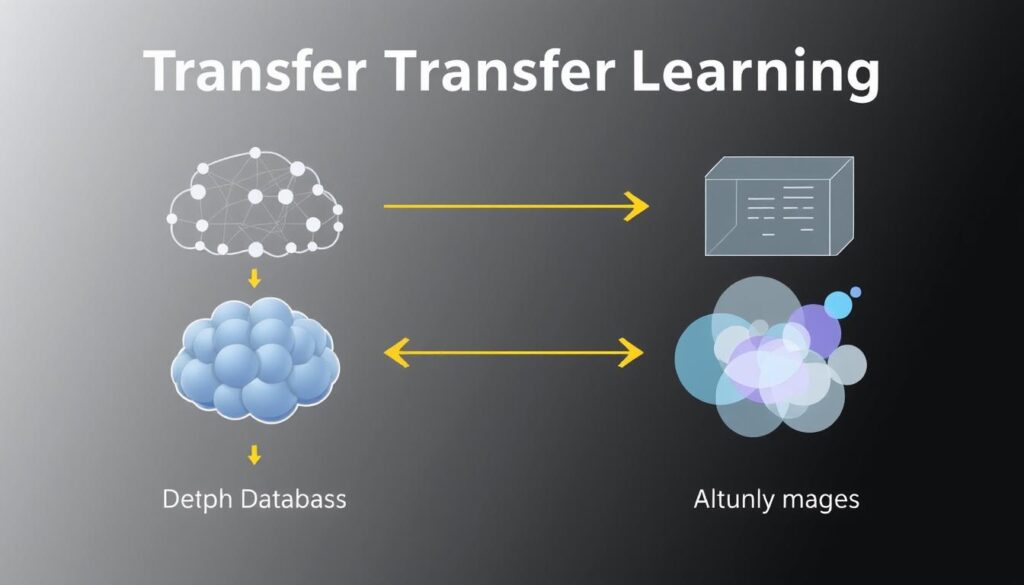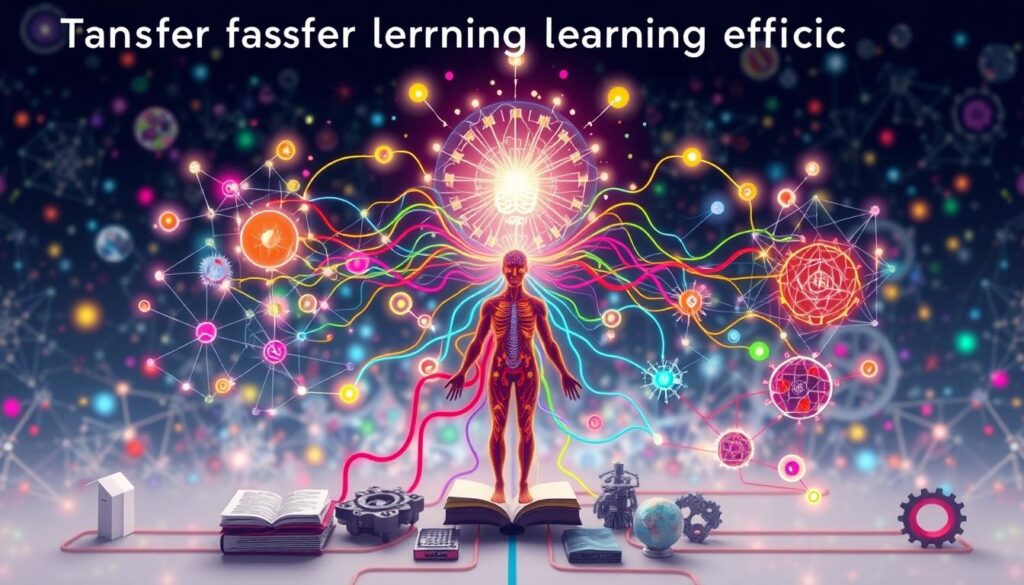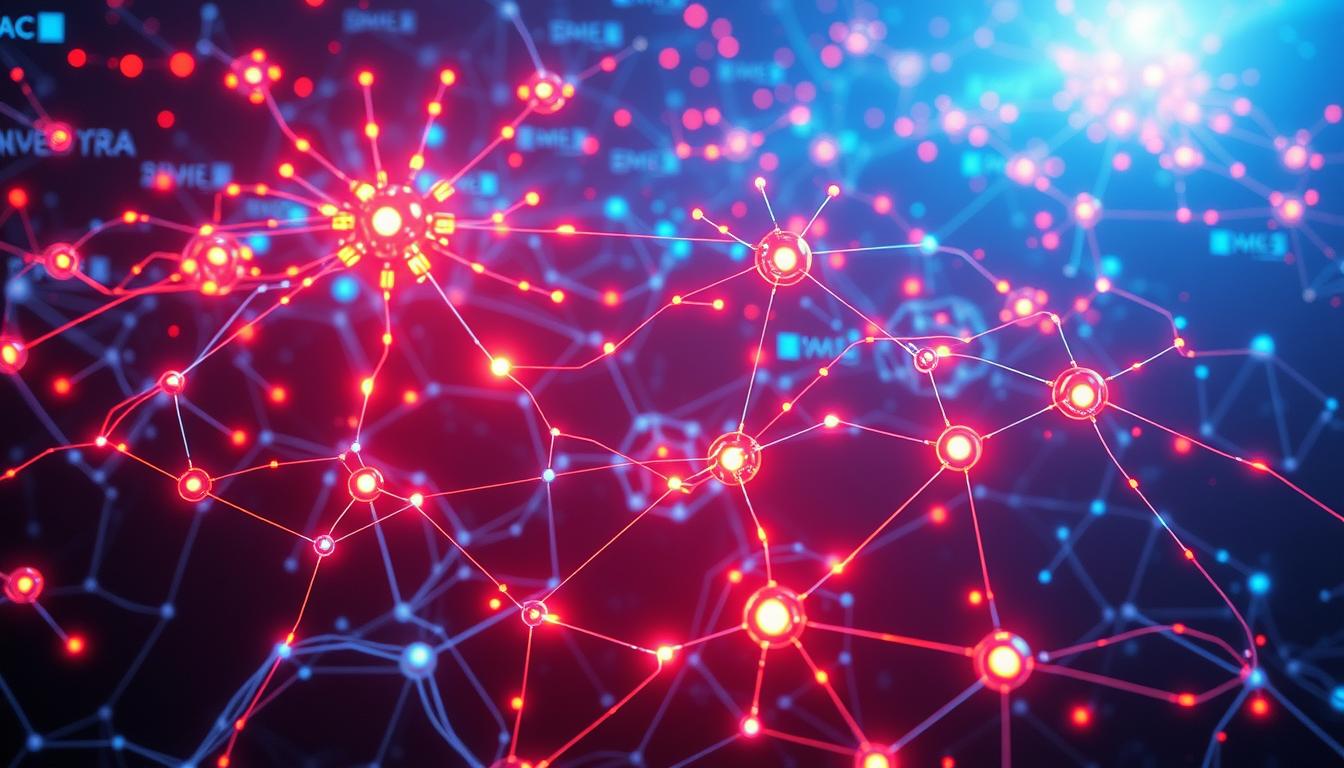“As an Amazon Associate I earn from qualifying purchases.” .
As I sit at my desk, staring at a mountain of data and a looming deadline, I feel overwhelmed. Training an AI model from scratch seems impossible. But then, I remember transfer learning. This approach has changed my work, making smarter models in less time.
Transfer learning is changing how we do machine learning. It uses pre-trained models to solve complex problems with less data and resources. This is very useful in image classification, where models trained on big datasets like ImageNet can be fine-tuned for specific tasks. This makes AI models more efficient, accurate, and adaptable.
The effects of transfer learning go beyond just tech. It’s making AI more accessible to smaller teams and organizations. With less data and training time, we’re seeing new uses across industries. From medical diagnosis to natural language processing, transfer learning is making AI solutions possible that were once thought impossible.
Key Takeaways
- Transfer learning significantly reduces AI model training time
- It requires less data for comparable performance
- Fine-tuned models often outperform those trained from scratch
- Ideal for complex tasks like image classification
- Democratizes AI by making advanced techniques more accessible
What is Transfer Learning?
Transfer learning is a big deal in Artificial Intelligence (AI). It helps machines learn faster by using knowledge from one task for another. This method is becoming popular in many areas, like computer vision and medical diagnosis.
Definition and Overview
Transfer learning lets AI models use what they learned from one task for another. It’s like how we use our past experiences to solve new problems. In AI, it means using a model trained on a big dataset for a new task. This is really helpful when dealing with domain adaptation challenges.
Key Concepts
To get transfer learning, you need to know a few important things:
- Source domain: The first task or dataset where the model learns its basics.
- Target domain: The new task or dataset where the model uses what it learned.
- Knowledge transfer: The act of using learned features from the source to the target domain.
Importance in AI
Transfer learning is key in AI for many reasons:
| Benefit | Description |
|---|---|
| Time Efficiency | Reduces training time a lot |
| Data Efficiency | Needs less data for new tasks |
| Performance Boost | Makes accuracy better in specific tasks |
This method is super useful in areas like medical image analysis. Datasets there are often small and specific. By using transfer learning techniques, models can get better results faster. This helps in diagnosing diseases and planning treatments more effectively.
“Transfer learning is the future of AI, allowing us to build smarter models with less data and time.”
How Transfer Learning Works
Transfer learning is a key technique in AI model development. It uses knowledge from pre-trained models for new tasks. This method involves several steps and data preparation for success.
The Process Explained
Transfer learning begins with choosing a pre-trained model. Then, developers adjust its structure for the new task. The most important step is fine-tuning, where the model learns from the target dataset.
This approach saves time and resources. It’s faster than building models from scratch.

Feature extraction is critical in transfer learning. The pre-trained model knows how to spot important features. This knowledge helps the new task, even with less data.
Data Preprocessing Techniques
Good data preprocessing is essential for model adaptation. Common techniques include:
- Normalization: Adjusting data to a standard scale
- Augmentation: Creating new data samples to increase dataset size
- Feature scaling: Ensuring all features contribute equally
These methods get the data ready for transfer learning. They help the model learn and adapt to new tasks better.
| Technique | Purpose | Impact |
|---|---|---|
| Normalization | Standardize data range | Improves model stability |
| Augmentation | Increase dataset size | Enhances model generalization |
| Feature scaling | Balance feature importance | Prevents domination by single features |
By following these steps and techniques, developers can create smarter, more efficient AI models.
Types of Transfer Learning
Transfer learning changes AI by letting models use knowledge in different areas. This makes them work better and faster in many tasks. Let’s look at the main types of transfer learning and what makes them special.
Inductive Transfer Learning
Inductive transfer learning uses knowledge from one task for another similar task. It’s very helpful when there’s not much data for the new task. For example, a model that recognizes images can be improved for medical images, needing less medical data.
Transductive Transfer Learning
Transductive transfer learning is for when the tasks are the same but the data is different. It’s great for adapting to new data. For instance, a model for movie reviews can be used for product reviews, helping with different types of text.
Unsupervised Transfer Learning
Unsupervised transfer learning works with data that has no labels. It’s key for tasks where models need to learn new things without examples. It’s very useful in understanding new languages or dialects without training data.
These types of transfer learning are the base for more advanced AI methods like multi-task learning and domain adaptation. By using pre-trained models and adjusting them for new tasks, AI systems can do much better and use less resources. This is very important in areas like computer vision and AI virtual assistance, where being able to adapt quickly is key.
Benefits of Transfer Learning
Transfer learning makes AI model development faster and better. It uses pre-learned features to speed up training and boost accuracy. This is very helpful for tasks like image classification and object detection.
Reduced Training Time
One big plus of transfer learning is how it shortens training time. AI developers can start with pre-trained models, skipping the long process of learning basic features. This is a big help when time is short or resources are limited.

Improved Model Accuracy
Transfer learning also makes models more accurate, even in tough tasks. For example, in object detection, using pre-trained weights from big datasets improves results. This is super useful in areas like self-driving cars and medical imaging, where getting things right is key.
| Application | Improvement |
|---|---|
| Object Detection | Enhanced accuracy using pre-trained weights |
| Semantic Segmentation | Improved pixel-level classification |
| Domain Adaptation | Better performance in different environments |
Transfer learning is great for working with small datasets. It lets models do well with less data, which is perfect for special areas like medical imaging. This method not only makes models more efficient but also boosts their performance in AI tasks.
Applications of Transfer Learning
Transfer learning has changed many fields, solving complex problems. It uses pre-trained models to cut down training time. This makes it work well in different areas.
Natural Language Processing
In Natural Language Processing, transfer learning is a big help. It’s great for analyzing feelings in text. By tweaking pre-trained models, companies can make fast and accurate tools for checking customer feedback or social media.
Computer Vision
Computer vision gets a lot from transfer learning, mainly in recognizing images. Models trained on big datasets like ImageNet help with tasks like finding objects or faces. This has greatly improved how well these tasks are done.
Medical Diagnosis
Transfer learning has also helped a lot in medical imaging. A study found it made classifying chest X-rays 10% more accurate than old methods. This helps doctors find diseases better and make more precise diagnoses.
| Application | Key Benefit | Performance Improvement |
|---|---|---|
| Sentiment Analysis | Rapid model development | Up to 15% accuracy increase |
| Image Recognition | Reduced training time | 20-30% efficiency boost |
| Medical Imaging | Enhanced disease detection | 10%+ accuracy improvement |
These examples show how transfer learning is useful in many fields. It helps make AI better and drives new ideas in important areas.
Challenges in Transfer Learning
Transfer learning is powerful but faces challenges. We’ll look at two main issues: domain mismatch and data quality problems.
Domain Mismatch
When the source and target domains are very different, transferring knowledge is hard. This can cause negative transfer, where the knowledge actually hurts performance. For example, a model trained on cat images might not do well with dogs.
Data Quality Issues
The quality of data in the target domain is critical. Poor or biased data can lead to overfitting. This means the model does well on the training data but fails elsewhere. Data bias can also make predictions unfair or wrong.
- Carefully select source models and datasets
- Use techniques to mitigate bias
- Improve data quality through preprocessing
- Implement regularization to prevent overfitting
By tackling these problems, we can make the most of transfer learning. This reduces training time and boosts model accuracy, even with limited data. For example, federated transfer learning can improve model performance while keeping data private. This is important in sensitive fields like healthcare and finance.
Best Practices for Implementing Transfer Learning
Using transfer learning well means paying attention to a few important things. By doing so, you can make your model better and more efficient.
Choosing Pre-trained Models
Choosing the right pre-trained model is key. Look for models that fit your task and domain. For example, BERT and RoBERTa are great for NLP tasks. ResNet and EfficientNet are good for computer vision.
When you have a small dataset, fine-tuning pre-trained models can be very helpful. This is true for tasks like sentiment analysis, where big datasets are rare.
Fine-tuning Techniques
Fine-tuning is a strong tool in transfer learning, but it needs to be done right. Here are some tips:
- Gradual unfreezing: Start by training only the last few layers, then gradually unfreeze earlier layers.
- Layer freezing: Keep initial layers frozen to retain useful features from the pre-trained model.
- Learning rate adjustment: Use smaller learning rates for pre-trained layers to prevent rapid changes.
Adjusting hyperparameters is key for the best results. Early stopping can help by stopping training when the validation metric stops improving. This is a common trick in TensorFlow and PyTorch.
| Technique | Benefits | Considerations |
|---|---|---|
| Feature Extraction | Quick and computationally cheap | Ideal for closely related domains |
| Fine-tuning | Better for domain-specific tasks | Resource-intensive, risk of overfitting |
| Layer Freezing | Prevents catastrophic forgetting | May limit adaptability to new tasks |
But, transfer learning can fail if the tasks are too different. In such cases, you might need custom loss functions or more fine-tuning to get the best results.
Transfer Learning Frameworks and Tools
AI frameworks and deep learning libraries are key in transfer learning. They make it easier to use pre-trained models for new tasks. Let’s look at some top frameworks for transfer learning.
TensorFlow
TensorFlow is a strong AI framework for transfer learning. It has pre-trained models and easy APIs. This makes it a favorite among developers.
With TensorFlow, you can quickly adjust models for different tasks. This includes image classification and natural language processing.
PyTorch
PyTorch is a well-liked deep learning library. It’s known for its dynamic computational graphs. It has a big ecosystem for transfer learning.
PyTorch’s flexibility is great for complex transfer learning. It’s perfect for trying out different model architectures.
Keras
Keras is now part of TensorFlow. It has high-level APIs for quick prototyping. Its easy interface is great for beginners and experts alike.
Keras makes it simple to use pre-trained models. You can fine-tune them for specific tasks easily.
These frameworks have led to big steps forward in AI. For example, AI-driven analytics has changed how we process data and make decisions.
| Framework | Key Features | Best For |
|---|---|---|
| TensorFlow | Extensive pre-trained models, production-ready deployment | Large-scale projects, mobile deployment |
| PyTorch | Dynamic graphs, research-friendly | Research, rapid prototyping |
| Keras | High-level APIs, quick experimentation | Beginners, fast model development |
Using these AI frameworks and libraries helps developers. They can quickly apply transfer learning. This speeds up making smart apps in many areas.
Future Trends in Transfer Learning
Transfer learning is changing fast, with new and exciting things happening. AI is getting better at learning quickly and efficiently.
Integration with Other AI Techniques
Transfer learning is now working with meta-learning to improve how AI adapts. This combination makes AI learn new tasks faster. Few-shot learning is also a big deal, letting AI learn from just a few examples.
Self-supervised learning is also making a splash. It lets AI learn from data without labels, reducing the need for human help. This is great when labeled data is hard to find or expensive.
Advancements in Pre-trained Models
Pre-trained models are getting stronger and more useful. They’re now the first choice for many AI tasks. These models can handle a variety of tasks, from understanding language to recognizing images.
Here’s a look at some recent advancements:
| Model | Advancement | Impact |
|---|---|---|
| ScaleCrafter | Ultra-high-resolution image generation | Surpasses training dataset resolutions |
| ProSpect | Attribute-aware personalization | No fine-tuning needed for diffusion models |
| LayerDiffusion | Transparent image and layer production | Enhances content control in image generation |
These advancements are making transfer learning more efficient and useful for more tasks and areas. As research keeps going, we can look forward to even more breakthroughs in transfer learning.
Case Studies of Successful Transfer Learning
Transfer learning has made big steps in real-world uses, changing how models work in many fields. Let’s look at two key examples that show how this method has made a big difference.
Google’s BERT for NLP
Google’s BERT changed how we understand natural language. This pre-trained model did very well in many language tasks. It shows how powerful transfer learning can be in NLP.
BERT’s success comes from its deep understanding of language. It used transfer learning to learn faster and more accurately. This helped it do better in tasks like answering questions and figuring out how people feel.
ResNet for Image Classification
ResNet is a deep learning framework that shows the power of transfer learning in computer vision. As a pre-trained model, ResNet made image classification tasks better. This led to better results in these tasks.
| Model | Task | Improvement |
|---|---|---|
| BERT | Question Answering | 11% accuracy increase |
| ResNet | Image Classification | 7% error rate reduction |
These examples show how transfer learning boosts AI model performance in different areas. By using pre-trained models, experts can get top results with less data and resources. This speeds up AI progress in many fields.
Conclusion: The Future of Transfer Learning in AI
Transfer learning is a key part of AI innovation. It changes how we solve machine learning problems. This method lets models use knowledge from one area to do well in another. It opens up new paths for research and use.
Lasting Impact on AI Development
Transfer learning has a big impact on AI. It saves time and resources by using pre-trained models. This lets developers fine-tune for specific tasks more easily.
This is very helpful when there’s not much data. For example, small companies can use training from many sources. This helps them predict better without sharing too much personal info.
Call to Action for Researchers and Practitioners
We need more innovation in transfer learning. Researchers and users should look into new uses, like in healthcare and self-driving cars. Federated transfer learning is a big chance to solve privacy issues while making models better.
By diving into these new areas, we can make AI more useful and fair. This will help everyone in society.
FAQ
What is transfer learning in AI?
How does transfer learning work?
What are the main types of transfer learning?
What are the benefits of using transfer learning?
In which fields is transfer learning commonly applied?
What are the main challenges in transfer learning?
What are some best practices for implementing transfer learning?
Which frameworks support transfer learning?
What are some future trends in transfer learning?
Can you give examples of successful transfer learning applications?
“As an Amazon Associate I earn from qualifying purchases.” .



